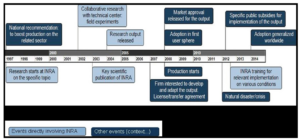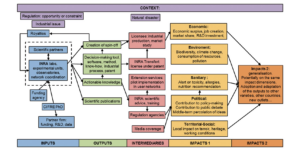Purpose: To identify and understand the ways in which research contributes to impact
Who is it for: researchers and project managers
Technique: interviews, desk research
Type of tool: implementation tool
Prior knowledge: considerable
Complexity: high
Duur: months
Downloads
Links
Related tools
What is ASIRPA?
ASIRPA stands for Analyse de l’impact sociétal de la recherche: analysis of social impact of research. It is a structured approach to identify social impact of research. Case studies are central to this, and the method provides a standardised way of describing cases. ASIRPA is intended both to provide accountability and insight into how impact is created.
ASIRPA is ideally suited for understanding impact at the level of a research organisation, a large research department or a substantial line of research. ASIRPA looks back at research and its contributions to impact. It is about understanding impact in retrospect, ex post.
The method is useful for research in any discipline. But ASIRPA was developed specifically for research in agriculture, food and the environment, which means that content choices have been made that are closely related to those disciplines. Application in other disciplines may require different choices, such as for relevant social impact domains.
One of the principles of ASIRPA is that impact is multidimensional: research can have impact in different societal domains. ASIRPA uses 5 impact domains: economic, political-governmental, environmental, health and location-specific impact. The latter impact is called territorial social in French and refers to the typically French agricultural concept of terroir.
Another starting point is that a whole network of actors is needed for research impact and that such networks partly already exist. Each actor plays its own role in that research or impact and does so at an appropriate time. Researchers and research organisations obviously play an important role in research impact, but they are not the only ones. ASIRPA has an eye for the whole context. It also considers actors who play a decisive role in the development of a new research funding programme, the further development into a product, the political decision to change a guideline, or the information about a new product or guideline. And ASIRPA also sees that product or guideline as an actor.
A final premise is that impact is not the result of an unambiguous and linear process but comes about through many iterations. Here again, that network plays a role: different actors develop and react to knowledge and insights, results and prototypes, at different times.
How to use Asirpa?
ASIRPA is all about case studies and so the method starts by choosing one or more cases. In developing the method, cases were chosen that were successful and led to impact. It is quite conceivable that the approach can also be used to learn from examples that have been less successful.
The development of the case study continues through a standardised process. And this is where ASIRPA differs from some other methods. The same aspects are covered in every case study and the same analyses are made. This makes it possible to do a meta-analysis of a series of cases. In developing this approach, this led to the characterisation of 4 types or types of impact that are common in the organisation for which the approach was developed. The three steps in developing the case study are: 1) chronology or timeline, 2) impact path, and 3) impact radar.
The chronology or timeline
The timeline describes at a high aggregate level key events related to the research and its impact. The timeline covers the period prior to the research, during the research and the period after, when the impact of the research becomes apparent. The inventory covers things like the development of research capacity and skills, or the development of facilities, but also something like new national policy on the research expertise, industry interest to develop knowledge further, and a crisis that gives an extra push to apply the knowledge or product further. These are crucial external factors.

(Res Eval, Volume 24, Issue 4, October 2015, Pages 440–453)
The impact path
The next step is a reconstruction of a more precise impact path. The focus is on aspects and mechanisms that contribute to impact. The concept of translation is important here: defining a common problem, involving and interesting relevant actors, defining roles and mobilising new actors.
Three specific components are characteristic of an ASIRPA impact path. (1) It includes productive configurations, or all financial, human, tangible and intangible contributions and investments by partners. So: royalties paid and reinvested, research infrastructure made available or developed for the research, existing knowledge networks. (2) Intermediaries that play an important role in making the knowledge usable. An intermediary can be a technology transfer organisation, a startup or a regulatory body, but also something like a prototype, or a training facility. ASIRPA is not only about people and organisations, but also about objects. (3) Thinking in terms of Impact 1 and Impact 2. Impact 1 is sometimes used as an intermediate impact or outcome in other models. Think of such diverse things as contributions to political decision-making, the introduction of food regulations or the creation of new jobs. Of interest is Impact 2. This is the second-order impact, which results from applying the knowledge on a larger scale. Think application to other varieties of a crop, application in another region (terroir), or scaling up a policy influenced by the research from regional to national level.

(Res Eval, Volume 24, Issue 4, October 2015, Pages 440–453)
The Impact radar
A final step in the development of the case is the mapping of impacts in the various societal domains: economic, political-governmental, environmental, health and location-specific impacts. The mapping of impacts is done partly through interviews with stakeholders, who describe specific examples of impact. To quantify impacts, from 1-weak to 5-strong, a score form has been developed for each of the five dimensions. For each case study, using that form, the importance of each of the five types of impact can be identified and depicted in a radar diagram. Such a diagram makes it clear briefly in which domains the research has high or low impact. Some research, such as policy advice, has mainly political-governmental impact, while genetic research into a specific animal disease has impact in all five domains, with an emphasis on health and site-specific impact.

What is the origin of ASIRPA?
ASIRPA was developed by a team of researchers and most of them are associated with the French Institut national de recherche pour l’agriculture, l’alimentation et l’environnement (INRAE). INRAE is an umbrella of research institutes in agriculture, food and the environment. Those institutes are somewhat like the institutes covered by the “Research” part of Wageningen University & Research in the Netherlands.
The researchers developed the method with and for colleagues within the INRAE institutes. It responds to the need within and outside INRAE to get a better grip on impact of the institute’s research. In developing it, the researchers used scientific knowledge and insights on innovation and social impact of research.
A key concern of the researchers/developers is that the ASIRPA method should be usable by their colleagues. Researchers and technology transfer professionals are trained and have access to standardised tools for chronology, impact path and radar diagram, and there is a report template. Although it seems labour-intensive, the method has already been adopted by some of the institutes when it was introduced. A decade after development of the method, the ASIRPA database contains some 60 cases.
ASIRPA builds on SIAMPI, Public Value Mapping, Payback Framework and Theories of Change, among others. The mechanism, or process, is central to all these tools or models. They are suitable for understanding the origins of impact, and they can be used for reflection and learning.
Another important conceptual influence underlying these tools, and certainly ASIRPA, is Actor Network Theory (ANT). ASIRPA uses the typical ANT concept of translation. This refers to changes in the network, more precisely both changes in the actors, and changes in the relationships between the actors. The focus on objects as actors in the network, rather than just people and organisations, is also characteristic of ANT.
A final important influence is CGIAR. This is a network of 14 research centres around the world, with an emphasis on Latin America, Africa and South and Southeast Asia. CGIAR is funded by a wide range of donors, including the Dutch Ministry of Foreign Affairs, the European Commission and the World Bank. CGIAR uses monitoring and evaluation both to learn from and be accountable for. And CGIAR monitors impact at a high level of aggregation and pays attention to second-order impacts, such as application of knowledge for another crop, in another region or country.
Following the introduction of ASIRPA, aimed at ex post impact mapping, the team further developed the methodology. In addition to ASIRPA ex post, there is now also ASIRPA Real-Time. This method is intended for use during research and allows research and programme leaders to remain impact oriented. ASIRPA Real-Time, in contrast to ASIRPA ex post, is meant for impact at the level of projects and programmes.





